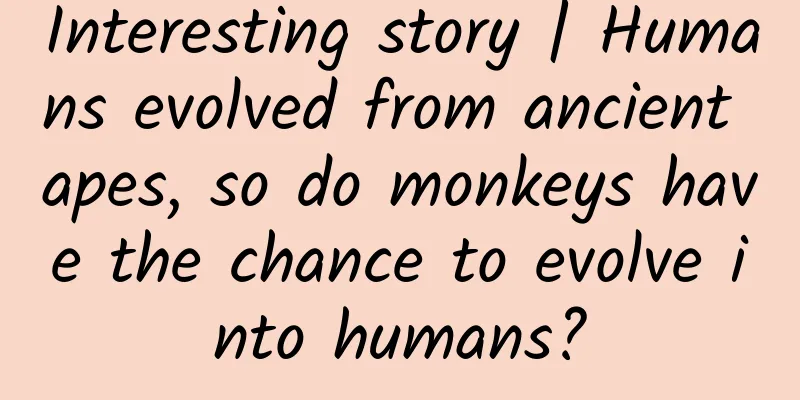Interesting story | Humans evolved from ancient apes, so do monkeys have the chance to evolve into humans?

|
About 65 million years ago, a large meteorite hit the Earth, causing the extinction of two-thirds of species, including the dinosaurs. From then on, the golden age of reptiles ended, but primitive mammals survived and evolved rapidly. In recent years, scientists have discovered a type of evolving monkey in Panama, which has attracted people's attention and made people wonder whether these monkeys have the opportunity to evolve into intelligent creatures like humans. Let's take a look. The evolution of human beings can be divided into the following four stages, namely Australopithecus, Homo habilis, Homo erectus and Homo sapiens. Among them, although Australopithecus can use natural tools, it cannot make tools. Homo habilis can make simple stone tools. Homo erectus can make stone tools for different purposes and can also use fire. Homo erectus is the most critical stage of human evolution. Homo sapiens has learned to make fire artificially and can make fine stone and bone tools. So what about the scientists' discovery of evolving Panamanian monkeys? Dr. Brendan Barrett of the Animal Behavior Research Institute found that there is a group of white-faced capuchin monkeys in Panama's Coiba National Park. These monkeys are able to use stone tools skillfully. How are they so skilled? These monkeys carefully select stones and then grind them into stone tools. They use different stone tools to dig soil, crack nuts and eat them, and also use wooden sticks. Isn't this very similar to the process of human evolution? The white-faced capuchin is a small New World monkey named after its tail, which is the same length as its body and curled into a circle. They mostly live in the rainforests of South and Central America. They are gentle and like to live in trees. However, what is strange to scientists is that not all white-faced capuchins have shown signs of evolution, only the male monkeys in Coiba National Park in Panama have. Being able to make and use tools is one of the necessary conditions for entering the Stone Age, but in addition to this, learning to use fire is also a necessary condition. Obviously, these Panamanian monkeys do not meet the condition of using fire, so it cannot be said that they have entered the Stone Age. In fact, more than 90% of the genes of humans and monkeys are the same. All species will evolve. Humans have been around for millions of years, while Panamanian monkeys are only about 3,000 years old. Real evolution also takes time. What do you think about this? Welcome to leave a message in the comment section. |
<<: Sand onion, a vegetable blind spot for southerners
>>: A Date with the Starry Sky丨This year’s Mid-Autumn Festival comes a little early
Recommend
A man's eyes were burned while clearing the toilet. Be careful when using pipe cleaners!
Mr. Yu from Zhejiang Province was cleaning the to...
Knowing that Guan Yu would let Cao Cao go, why did they send him to Huarong Road?
Mixed Knowledge Specially designed to cure confus...
7 cases of strategic product operations!
In practice, product operators often face many pr...
I always feel that men are greasy, but why are men's faces more oily?
Sometimes I have to sigh that it is not easy for ...
One article to understand how to build a national campus channel
With the rise of mobile Internet , the campus mar...
Magnolia family illustrations, which ones do you see?
"The green branches are so strong that they ...
How to efficiently learn and master new technologies
Recently, I have learned and practiced React, whi...
The stainless steel kettle at home always has black stuff on it, what's going on? Is it poisonous?
I don’t know if you have ever encountered this si...
What is the price of the Xianyang Automobile Annual Inspection Mini Program? Xianyang Automobile Annual Inspection Mini Program Merchant Price Inquiry
How much does it cost to invest in the Xianyang A...
This article teaches you how to build a self-media matrix and acquire customers at low cost!
Someone asked me: Without money or resources, can...
How terrible is the only insect that can live in Antarctica?
Compared to the Arctic, Antarctica is much more d...
Wentian Laboratory, what is it going to do in space?
Mixed Knowledge Specially designed to cure confus...
An 8-year-old boy's myopia worsened by 75 degrees in half a year. His mother's "just wait and see" delayed him! What should I do if my child is myopic?
"My child is still young, and I don't wa...
iPhone 12 will be released at a different time, is Apple bowing to the market again?
It’s been a week since the grand launch of iPhone...
Apple makes concession: iPhones with batteries you’ve replaced can also be repaired
According to foreign media reports, Apple's i...









